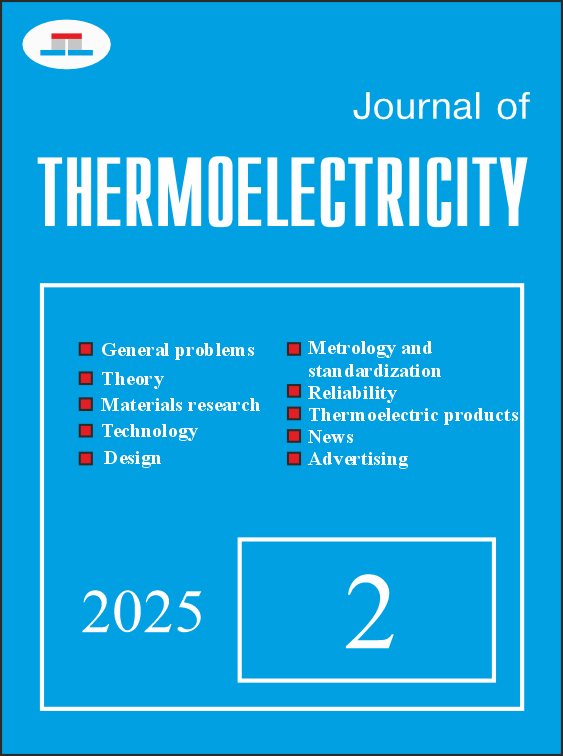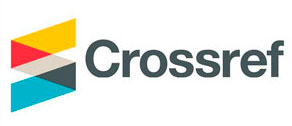Effect of Acoustic Phonons on Thermoelectric Properties of Lead Iodide Nanofilms
DOI:
https://doi.org/10.63527/1607-8829-2025-2-5-16Keywords:
nanostructure, phonon, spectrum of frequencies and group velocities, thermal conductivity, thermoelectric figure of merit, thermoelectric materials, lead iodideAbstract
The effect of spatial confinement on the propagation velocity of acoustic phonons in planar quasi-2D nanostructures (nanofilms) based on the layered semiconductor 2H-PbI2, thermal conductivity coefficient and thermoelectric figure of merit is investigated within the approximation of elastic continuum using the elasticity theory. It is shown that the biggest influence on the thermal conductivity of lead iodide nanofilms is exerted by acoustic phonons, which belong to the dilatational vibrations of the crystal lattice atoms. The predominant mechanism of relaxation of all types of confined acoustic phonons in a nanofilm at a moderate concentration of impurities is the phonon-phonon (Umnklapp) interaction. Its efficiency depends on the nanofilm thickness and temperature. The velocities of phonons propagation also depend on these parameters. These features lead to a rapid decrease of thermal conductivity at smaller nanofilm thickness and bigger temperature, contributing to increasing thermodynamic figure of merit of the nanostructure. Estimation of the thermodynamic figure of merit for ultrathin (several layers of 2H-PbI2) films bring to the conclusion that they are suitable for the fabrication of thermoelectric devices, which can operate at room and higher temperatures.
References
1. Anatychuk, L. I., & Vikhor, L. N. (2012). Thermoelectricity: Monograph. Vol. IV. Functionally graded thermoelectric materials. Institute of Thermoelectricity.
2. Tsakalakos, T. (2003). Nanostructures and nanotechnology: Perspectives and new trends. In T. Tsakalakos, I. A. Ovid’ko, & A. K. Vasudevan (Eds.), Nanostructures: Synthesis, Functional Properties and Applications (Vol. 128, NATO Science Series II). Springer. https://link.springer.com/chapter/10.1007/978-94-007-1019-1_1
3. Venkatasubramanian, R., Siivola, E., Colpitts, T., & O'Quinn, B. (2011). Thin-film thermoelectric devices with high room-temperature figures of merit. Nature, 413, 597–602. https://doi.org/10.1038/35098012
4. Pennelli, D. (2014). Review of nanostructured devices for thermoelectric applications. Beilstein Journal of Nanotechnology, 5, 1268–1284. https://doi.org/10.3762/bjnano.5.141
5. Tayari, V., Senkovskiy, B. V., Rybkovskiy, D., et al. (2018). Quasi-two-dimensional thermoelectricity in SnSe. Physical Review B, 97, 045424. https://doi.org/10.1103/PhysRevB.97.045424
6. Liu, X., Ha, S. T., Zhang, Q., et al. (2015). Whispering gallery mode lasing from hexagonal shaped layered lead iodide crystals. ACS Nano, 9(1), 687–695. https://doi.org/10.1021/nn5061207
7. Lu, N., & Guan, J. (2022). Thermoelectric performance of XI2 (X = Ge, Sn, Pb) bilayers. Chinese Physics B, 31, 047201. https://doi.org/10.1088/1674-1056/ac474C
8. Hu, Y. F., Yang, J., Yuan, Y. Q., & Wang, J. W. (2019). GeI2 monolayer: A model thermoelectric material from 300 to 600 K. Philosophical Magazine, 100(6), 782–796. https://doi.org/10.1080/14786435.2019.1699670
9. Naseri, M., Hoat, D. M., Salehi, K., & Amirian, S. (2020). Theoretical prediction of 2D XI2 (X = Si, Ge, Sn, Pb) monolayers by density functional theory. Journal of Molecular Graphics and Modelling, 95, 107501. https://doi.org/10.1016/j.jmgm.2019.107501
10. Zhong, M., Zhang, S., Huang, L., et al. (2017). Large-scale 2D PbI2 monolayers: Experimental realization and their band-gap related properties. Nanoscale, 9(11), 3736–3741. https://doi.org/10.1039/C6NR07924E
11. Zheng, W., Zhang, Z., Lin, R., et al. (2016). High-crystalline 2D layered PbI2 with ultrasmooth surface: Liquid-phase synthesis and application of high-speed photon detection. Advanced Electronic Materials, 2(11), 1600291. https://doi.org/10.1002/aelm.201600291
12. Wangyang, P., Sun, H., Zhu, X., et al. (2016). Mechanical exfoliation and Raman spectra of ultrathin PbI2 single crystal. Materials Letters, 168, 68–71. https://doi.org/10.1016/j.matlet.2016.01.034
13. He, K., Zhu, J., Li, Z., et al. (2023). High-sensitive two-dimensional PbI2 photodetector with ultrashort channel. Frontiers of Physics, 18, 63305. https://doi.org/10.1007/s11467-023-1323-1
14. Shah, K. S., Olschner, F., Moy, L. P., et al. (1996). Lead iodide X-ray detection systems. Nuclear Instruments and Methods in Physics Research Section A, 380(1–2), 266–270. https://doi.org/10.1016/S0168-9002(96)00346-4
15. Shah, K. S., Bennett, P., Klugerman, M., et al. (1997). Lead iodide optical detectors for gamma ray spectroscopy. IEEE Transactions on Nuclear Science, 44(3), 448–450. https://doi.org/10.1109/23.603688
16. Peng, B., Mei, H., Shao, H., et al. (2019). High thermoelectric efficiency in monolayer PbI2 from 300 K to 900 K. arXiv preprint arXiv:1811.04244v2. https://www.osti.gov/servlets/purl/1556115
17. Zincenco, N. D., Nika, D. L., Pokatilov, E. P., & Balandin, A. A. (2007). Acoustic phonon engineering of thermal properties of silicon-based nanostructures. Journal of Physics: Conference Series, 92, 012086. https://doi.org/10.1088/1742-6596/92/1/012086
18. Balandin, A. A., Pokatilov, E. P., & Nika, D. L. (2007). Phonon engineering in hetero- and nanostructures. Journal of Nanoelectronics and Optoelectronics, 2, 140–170. https://doi.org/10.1166/jno.2007.201
19. Cröll, A., Tonn, J., Post, E., et al. (2017). Anisotropic and temperature-dependent thermal conductivity of PbI2. Journal of Crystal Growth, 466, 16–21. https://doi.org/10.1016/j.jcrysgro.2017.03.006
20. Ran, R., Cheng, C., Zeng, Z., et al. (2019). Mechanical and thermal transport properties of monolayer PbI2 via first-principles investigations. Philosophical Magazine, 99(10), 1277–1296. https://doi.org/10.1080/14786435.2019.1580818
21. Guo, P., Stoumpos, C. C., Mao, L., et al. (2018). Cross-plane coherent acoustic phonons in two-dimensional organic-inorganic hybrid perovskites. Nature Communications, 9, 2019. https://doi.org/10.1038/s41467-018-04429-9
22. Yağmurcukardeş, M., Peeters, F. M., & Sahin, H. (2018). Electronic and vibrational properties of PbI2: From bulk to monolayer. Physical Review B, 98, 085431. https://doi.org/10.48550/arXiv.1807.09140
23. Bolen, E., Deligoz, E., & Ozisik, H. (2021). Origin of low thermal conductivity in monolayer PbI2. Solid State Communications, 327, 114223. https://doi.org/10.1016/j.ssc.2021.114223
24. Lutsiuk, Y., Kramar, V., & Petryk, I. (2021). Frequency spectrum and group velocities of acoustic phonons in PbI2 nanofilms. Physics and Chemistry of Solid State, 23(3), 478–483. https://doi.org/10.15330/pcss.23.3.478-483
25. Lutsiuk, Y. (2024). Temperature dependences of the averaged group velocities of acoustic phonons in flat nanofilms of lead iodide. Physics and Educational Technology, 2, 40–46. https://doi.org/10.32782/pet-2024-2-6
26. Bannov, N., Mitin, V., & Stroscio, M. (1994). Confined acoustic phonons in a free-standing quantum well and their interaction with electrons. Physica Status Solidi (b), 183(1), 131–142. https://doi.org/10.1002/pssb.2221830109
27. Pokatilov, E. P., Nika, D. L., & Balandin, A. A. (2003). Phonon spectrum and group velocities in AlN/GaN/AlN and related heterostructures. Superlattices and Nanostructures, 33, 155–171. https://doi.org/10.1016/S0749-6036(03)00069-7
28. Zhang, Y. (2016). First-principles Debye-Callaway approach to lattice thermal conductivity. Journal of Materiomics, 2, 237–247. https://doi.org/10.1016/j.jmat.2016.06.004
29. Lutsiuk, Y. V., & Kramar, V. M. (2020). Analytical calculation of frequency spectrum and group velocities of acoustic phonons in quasi-two-dimensional nanostructures. Journal of Nano- and Electronic Physics, 12(5), 05033. https://doi.org/10.21272/jnep.12(5).05033
30. Street, R. A., Mulato, M., Schieber, M., et al. (2001). Comparative study of PbI2 and HgI2 as direct detector materials for high resolution X-ray image. Proceedings of SPIE, 4320, 1–12. https://doi.org/10.1117/12.430858
31. Holland, M. G. (1963). Analysis of lattice thermal conductivity. Physical Review, 132, 2461. https://doi.org/10.1103/PhysRev.132.2461
32. Ansari, M., Ashokan, V., Indu, B., & Kumar, R. (2012). Lattice thermal conductivity of GaAs. Acta Physica Polonica A, 121(3), 639–646. https://doi.org/10.12693/APhysPolA.121.639
33. Grüneisen, E. (1912). Theorie des festen Zustandes einatomiger Elemente. Annalen der Physik, 344(12), 257–306. https://doi.org/10.1002/andp.19123441202
34. Nitsch, K., & Rodová, M. (2002). Thermomechanical measurements of lead halide single crystals. Physica Status Solidi (b), 234(2), 701–709. https://doi.org/10.1002/1521-3951(200211)234:2<701::AID-PSSB701>3.0.CO;2-1
35. Mingo, N. (2003). Calculation of Si nanowire thermal conductivity using complete phonon dispersion relations. Physical Review B, 68(11), 113308. https://doi.org/10.1103/PhysRevB.68.113308




